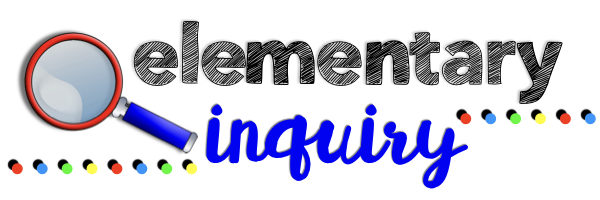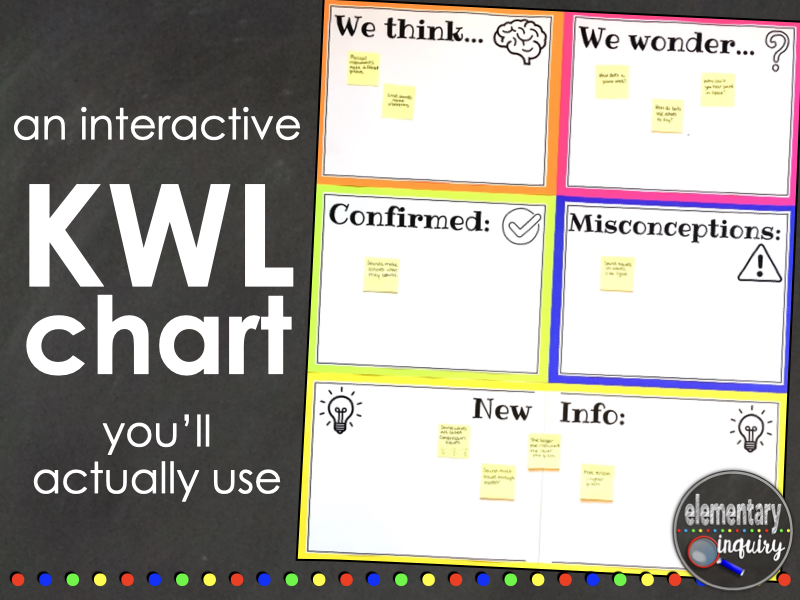
The KWL Chart (Know/Want to know/Learned) is a great tool for helping students activate prior knowledge and review concepts that have been learned. It’s one of the first graphic organizers most pre-service teachers learn about, and teachers use it across all grade levels and subject areas. However, I don’t think a KWL chart serves its full potential when – if you’re always rushed for time like I am – the first two columns are filled out at the beginning of a unit, only to hastily return at the end to fill out the final column, if anything ever gets recorded there at all. (Or are you way more on top of things than I am and always have a detailed KWL chart posted in your room by the end of a unit?)
I have found that a few simple changes to my KWL charts transformed them into daily tools for reflection, inquiry, and keeping students’ curiosity engaged throughout any unit. Click here to receive a free, printable copy of these materials in your email!

First, I’ve retitled the “I Know” section “I think/I know” to leave room for students’ ideas that they’re unsure about and to acknowledge that we sometimes uncover more nuance to facts we think we know. As we work through the unit of study, we classify each statement in this section as either Confirmed, along with supporting evidence, or Misconceptions, once students can articulate and correct the flaws in their original reasoning. You can rewrite these statements as needed, used colored pencils or highlighters to code ideas as confirmed or misconceptions, or write on sticky notes so that ideas can be moved from one section to another.
The “I wonder” section stays the same. You can use this section to foster an inquiry based learning environment by recording students’ questions as often as they arise, whether your unit plans will address the questions or not. Your students may surprise you with how deeply they want to investigate a topic!
Finally, the third section, “New Information I’ve Learned” is just that – a space to record new facts and concepts as they come up.

Here are a few additional tips for using this upgraded KWL chart to keep your students thinking, wondering, and reflecting about your topic of study:
- Update the chart daily! Classroom time is so scarce that it can be hard to stop a lesson 5 minutes early, but building in time for students to reflect on their learning is crucial. Take 3-5 minutes at the end of each lesson to ask students if they’ve confirmed any facts, identified misconceptions, learned new information, or are wondering about other ideas. Update the KWL chart to reflect students’ current learning.
- Meet your students’ needs by keeping a class chart, individual charts, or both. If you display a KWL chart for the entire class, include all students’ ideas. Set the expectation that anything can be added to the “I think/I know” and “I wonder” sections; consensus is only needed for confirming ideas, correcting misconceptions, and adding new information learned.
- Use sticky notes! This updated approach to KWL charts highlights how we are constantly absorbing and categorizing the information we take in, and sticky notes are the perfect way to facilitate that process.
- Post a word wall or word splash in your classroom at the beginning of the unit. I like to include 10-20 essential vocabulary words, some of which are probably familiar to most students and plenty that are new. Students can use these words to jog their memory or their curiosity at the beginning of the unit. By the end of the unit, all of the words should be used correctly on the KWL chart.

When I made these changes to KWL charts in my classroom, I noticed a huge difference in my students’ engagement with our topics of study. Their ideas in the “I wonder” section became especially insightful and led to deep discussions and fascinating student-led investigations.
I hope you’ll give these changes a try to take your KWL charts to the next level. Please grab these free printable KWL charts here so that you can try them out right away!
This month, I’ve teamed up with some awesome upper elementary bloggers to talk about inspiring students’ curiosity and wonder in the classroom.

Check out these other ideas for inspiring wonder and curiosity below:
“Writing Riddles” for Mini-Research in Science | Tarheelstate Teacher
3 Ways to Strengthen Student Questioning During Reading | Think Grow Giggle
Modifying Math Word Problems to Encourage Curiosity | Mix and Math
Wonder Walls & STEM Challenges | Kerry Tracy
Word Wonders: Collecting Multisyllabic Words | Reading by Heart
Using Visible Thinking to Read With Wonder | Wild Child’s Mossy Oak Musings
Stimulating Curiosity through Questioning | The Owl Teacher
Inspiring Curiosity through Technology | Love Learning
Mathematicians Inspire Wonder & Curiosity | Tried and True Teaching Tools
Curiosity in the Classroom: Five Steps to Engagement and Creativity | Mikey D Teach

